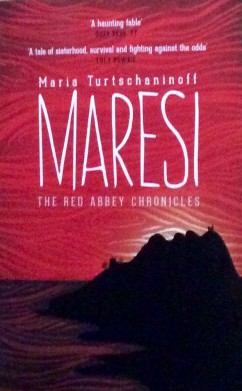Inspiring Young Readers
 posted on 03 Feb 2017
posted on 03 Feb 2017
Maresi by Maria Turtschaninooff
This dark and thrilling little tale is the first book in the Red Abbey trilogy and is soon to be made into a major feature film. The many reviewers quoted in the book itself have deemed it to be ‘A great addition to the growing feminist fantasy genre’ (Scotsman); ‘frightening plausibility of the dangerous world it creates’ (Telegraph) and ‘combines a flavour of The Handmaid’s Tale with bursts of excitement reminiscent of Harry Potter’s magic deeds’ ( Observer). I was aware of all these very positive accolades as I started to read it and rather wish that I had come to it without their influence in case I was disappointed.
Thankfully, I would agree that this is indeed an extraordinary and beautifully written story, translated by A.A.Prime. The award winning Swedish author has apparently been writing fairy tales since the age of five and her easy familiarity with the other- worldly atmosphere is clear from the opening scene. Like many readers, I welcome a map to help me visualise a fictional territory so I was very pleased to see detailed maps of the Red Abbey and the island. The young girl Maresi then begins to tell her story which she warns us is not a happy one:
‘I can still recall certain things I would rather forget. The smell of blood. The sound of crunching bones. I do not want to bring it all up again. But I have to. It is difficult to write about death. But I have to’.
Maresi has lived in the sanctuary of the abbey for four years having arrived like all the other girls, to find refuge from a world where all females suffer varying degrees of oppression and to learn wisdom from the learned women who have established a unique self- sufficient colony that takes care of all the girls that arrive there. No men are allowed to live there but over a long time, some trust has built up so that fishing boats now regularly bring supplies and some reciprocal trade is accepted. The wealth of the community relies on the yearly harvest of the blood snails who live on the island and provide a rare and much sought after red dye ( hence the name of the abbey).
Maresi explains that she was sent to live on the island because of a terrible period known as ‘the Hunger Winter.’ Living there has changed her view of the world and made her very glad to be away from the harshness and discomfort of the home where she spent her early years. She has become acclimatised to the gentle rhythm of the days and is now highly regarded by the women and the younger girls. All seems to promise an uneventful but safe future and she is reluctant to think of leaving the tranquillity and safety of such a pleasant place. Everything changes with the arrival of a new girl, Jai who has escaped from a life of unimaginable cruelty. Their close friendship develops and life continues to be sweet for a while but I just knew that trouble wasn’t far away because, after all it would be a bit boring otherwise.
It transpires that Jai is still in great danger and that her cruel father is determined to pursue her so that he can punish her for running away. This puts everyone in a vulnerable position and when he arrives on the island with his army, Maresa is forced to make some hard decisions.
The strength of the female sisterhood has evolved from ancient beliefs about a female deity and there are many associated rituals that focus on the power of the moon, the significance of menstrual blood and so on. Much of the story hangs on the powerful spiritual experience that Maresi has that ultimately protects her from death and helps her to understand the meaning of life. I personally found the magical/ religious component rather hard to like, but this might just be because I am cynical and so could not sufficiently suspend my disbelief. Despite this I really enjoyed the sense of adventure and peril in the story and so look forward to reading the next episodes.
Karen Argent
January 2017